Note: Poster #8 is cross-listed in the category of "Research on Health Disparities, in memory of Mitchell Stewart." Posters #14 and #17 is cross-listed in the category of Innovative Solutions to Public Health Challenges.
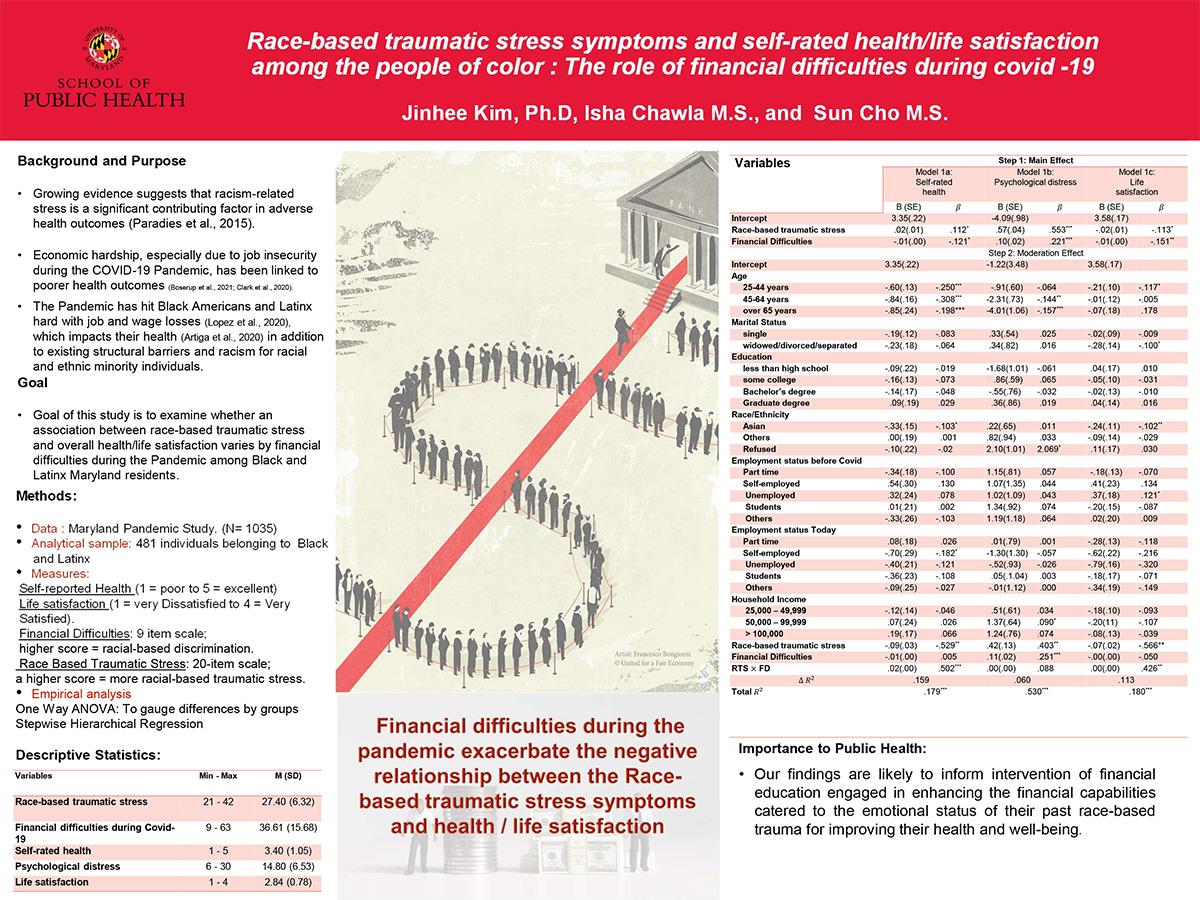
Poster # 8
Title: Race-based traumatic stress symptoms and self-rated health/life satisfaction among the people of color: The role of financial difficulties during covid -19
Presenting Author: Isha Chawla (doctoral student - Department of Family Science, UMD School of Public Health)
Authors: Sun Cho (Graduate Student ) Department of Family Science, Dr. Jinhee Kim
Faculty Mentors: Dr. Jinhee Kim
Primary Category: COVID-19
Secondary Category: Research on Health Disparities, in Memory of Mitchell Stewart
Background: Growing evidence suggests that racism-related stress is a significant contributing factor in adverse health outcomes (Paradies et al., 2015). Adverse health outcomes include depression, psychological distress, and poorer physical health(Aarons et al., 2008). Economic hardship, especially due to job insecurity during the COVID-19 Pandemic, has been linked to poorer health outcomes (Boserup et al., 2021; Clark et al., 2020). In addition to existing structural barriers and racism for racial and ethnic minority individuals, the Pandemic has hit Black Americans and LatinX hard with job and wage losses (Lopez et al., 2020), which impacts their health (Artiga et al., 2020). Additionally, Black or African American or LatinX has reported increased hate bias incidents during the Pandemic (Watkins, 2021). Financial difficulties during the Pandemic could exacerbate race-based stress. In the light of these trends, we examine whether an association between race-based traumatic stress and overall health/life satisfaction varies by financial difficulties during the Pandemic among Black and LatinX Maryland
Goals: Goal of this study is to examine whether an association between race-based traumatic stress and overall health/life satisfaction varies by financial difficulties during the Pandemic among Black and Latinx Maryland residents
Objectives: Financial Difficulties will negatively and significantly moderate the relationship between race-based traumatic stress and overall health/life satisfaction
Approach/Methods: This study utilized the data collected from Maryland residents using the Qualtrics panel, collected in months, 2021. A total 1,035 was collected, and our sample was restricted to 481 individuals only belonging to Black and LatinX. The dependent variable in this study is Self-reported Health (1 = poor to 5 = excellent) and Life satisfaction (1 = very Dissatisfied to 4 Very Satisfied). The independent variable included in the study is race-based traumatic stress symptoms (Carter, 2013), a 20-item scale; a higher score represented more racial-based discrimination) an financial difficulties ( 9 item scale; higher score represented more financial difficulties during Covid-19) as a moderator. Our covariates include age, marital status, education level, employment status, household income, as determined by conducting one-way ANOVA how financial difficulties were measured.
Results: Financial difficulties during the Pandemic significantly moderate the association between race-based traumatic stress and self-rated health and life satisfaction.
Importance to public health: Our findings are likely to inform intervention of financial education engaged in enhancing the financial capabilities catered to the emotional status of their past race-based trauma for improving their health and well-being.
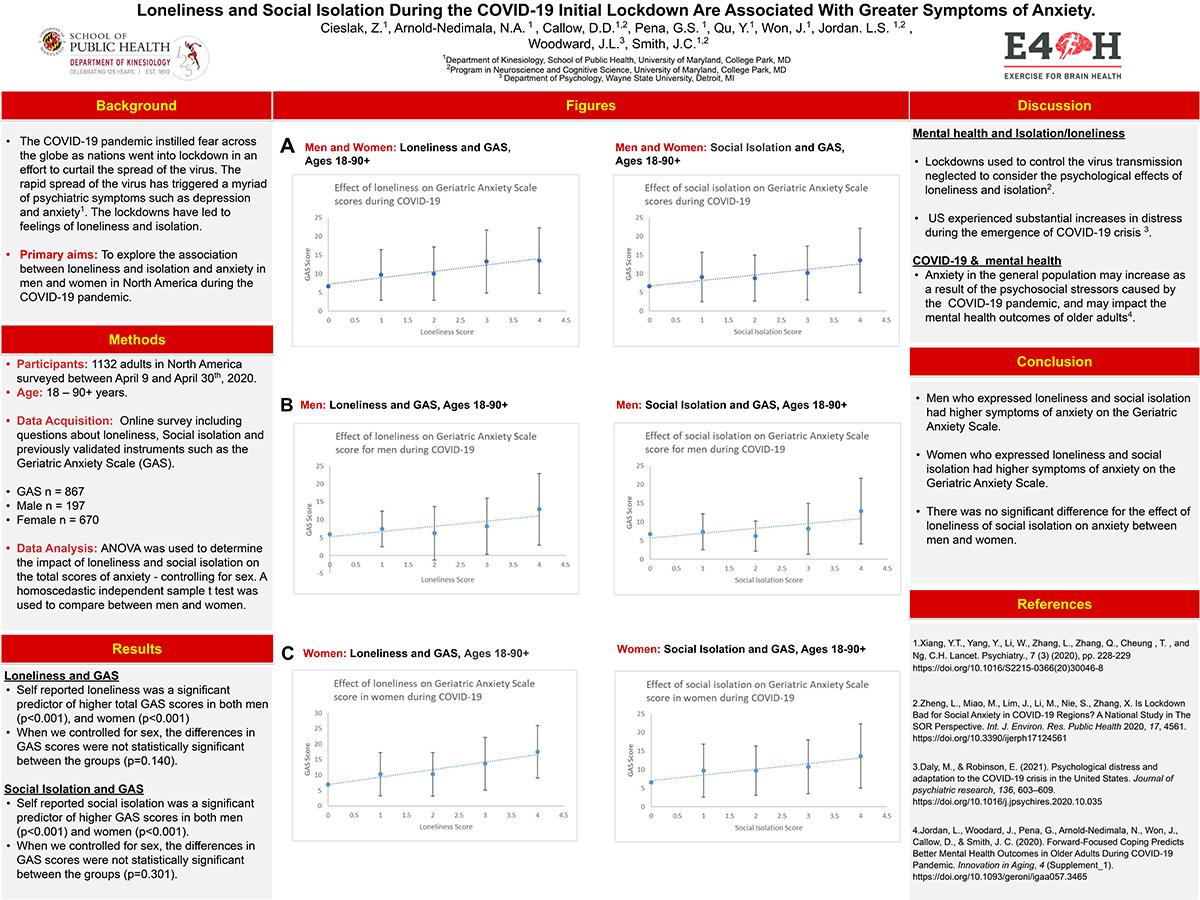
Poster # 9
Title: Loneliness and Social Isolation During the COVID-19 Initial Lockdown Are Associated With Greater Symptoms of Anxiety
Presenting Author: Zofia Cieslak, undergraduate student, Department of Kinesiology
Authors: Naomi Arnold-Nedimala; Department of Kinesiology; graduate student
Faculty Mentors: Dr. J. Carson Smith
Primary Category: COVID-19
Secondary Category: Behavioral Health, Mental Health, Substance Abuse
Background: The COVID-19 pandemic caused nations to go into lockdown in an effort to curtail the spread of the virus. The rapid spread of the virus has triggered a myriad of psychiatric symptoms such as depression and anxiety.
Goals: The goal of this project is to determine if loneliness and social isolation during COVID-19 lockdown is associated with higher symptoms of anxiety.
Objectives: We hypothesize that loneliness and social isolation will increase the participants' scores on the Geriatric Anxiety Scale.
Methods: Data was collected through an online survey from 1132 adults in North America in April 2020 during the initial COVID-19 lockdown.
Results: Men who expressed loneliness and social isolation had higher symptoms of anxiety on the Geriatric Anxiety Scale. Women who expressed loneliness and social isolation had higher symptoms of anxiety on the Geriatric Anxiety Scale. There was no significant difference for the effect of loneliness of social isolation on anxiety between men and women.
Importance to public health: Mental health outcomes are an increasing public health issue, and understanding the effect of COVID-19 is crucial.

Poster # 10
Title: Impact of SARS-CoV-2 variants on viral load in exhaled breath aerosols
Presenting Author: Kristen Coleman, Assistant Research Professor, Maryland Institute for Applied Environmental Health, UMD School of Public Health
Authors: Kristen Coleman, Assistant Research Professor, Maryland Institute for Applied Environmental Health, UMD School of Public Health; Jianyu Lai (doctoral student - Department of Epidemiology and Biostatistics, UMD School of Public Health)
Primary Category: COVID-19
Background: The transmissibility of severe acute respiratory syndrome coronavirus 2 (SARS-CoV-2) continues to increase as new variants emerge.
Goals: Determine if highly transmissible SARS-CoV-2 variants are associated with more efficient aerosol shedding.
Objectives: We aimed to collect saliva, mid-turbinate swabs (MTS) and exhaled breath aerosol (EBA) samples from people with a SARS-CoV-2 infection and examine the samples for SARS-CoV-2 RNA copies and infectious virus.
Approach/Methods: We collected 30-minute EBA samples with a Gesundheit-II using a loud speaking and singing protocol. Samples were assayed using the TaqPath COVID-19 Real Time PCR Assay (Thermo Scientific) and aliquots were sent to the University of Maryland School of Medicine for virus culture using TMPRSS2-expressing VeroE6 cells and A549-ACE2 cells.
Results: From June 6, 2020 through March 3, 2022, we collected saliva, MTS and EBA from 89 people with mildly symptomatic SARS-CoV-2 infection. Forty (45%) and 28 (32%) of the participants had detectable viral RNA in fine and coarse EBA, respectively. Infectious SARS-CoV-2 was recovered from EBA of six participants, including one pre-Alpha, one Alpha, two Delta, and two Omicron BA.1.1 cases. These two Delta and two Omicron cases were fully vaccinated and one Omicron case was boosted (received a third mRNA vaccine dose). Infectious virus was recovered from five fine and one coarse EBA sample, the latter from a Delta case. Compared to previous variants, fine EBA viral RNA loads were higher overall for Omicron cases (p=0.0078), despite the highest values being associated with lower MTS viral RNA loads. MTS viral RNA load was a weak predictor of EBA viral RNA load for Omicron cases, in contrast to previous variants where it was a moderate predictor. For Omicron cases, viral RNA loads in saliva remained moderately correlated with that in EBA.
Importance to Public Health: This study demonstrates that when compared to previous SARS-CoV-2 variants, Omicron sheds more efficiently via fine aerosols, and vaccinated/boosted individuals can shed infectious virus via aerosols. In addition to vaccination, public health measures such as masking and indoor air cleaning (e.g., ventilation, filtration, upper-room UVGI) are still needed to mitigate COVID-19 transmission.
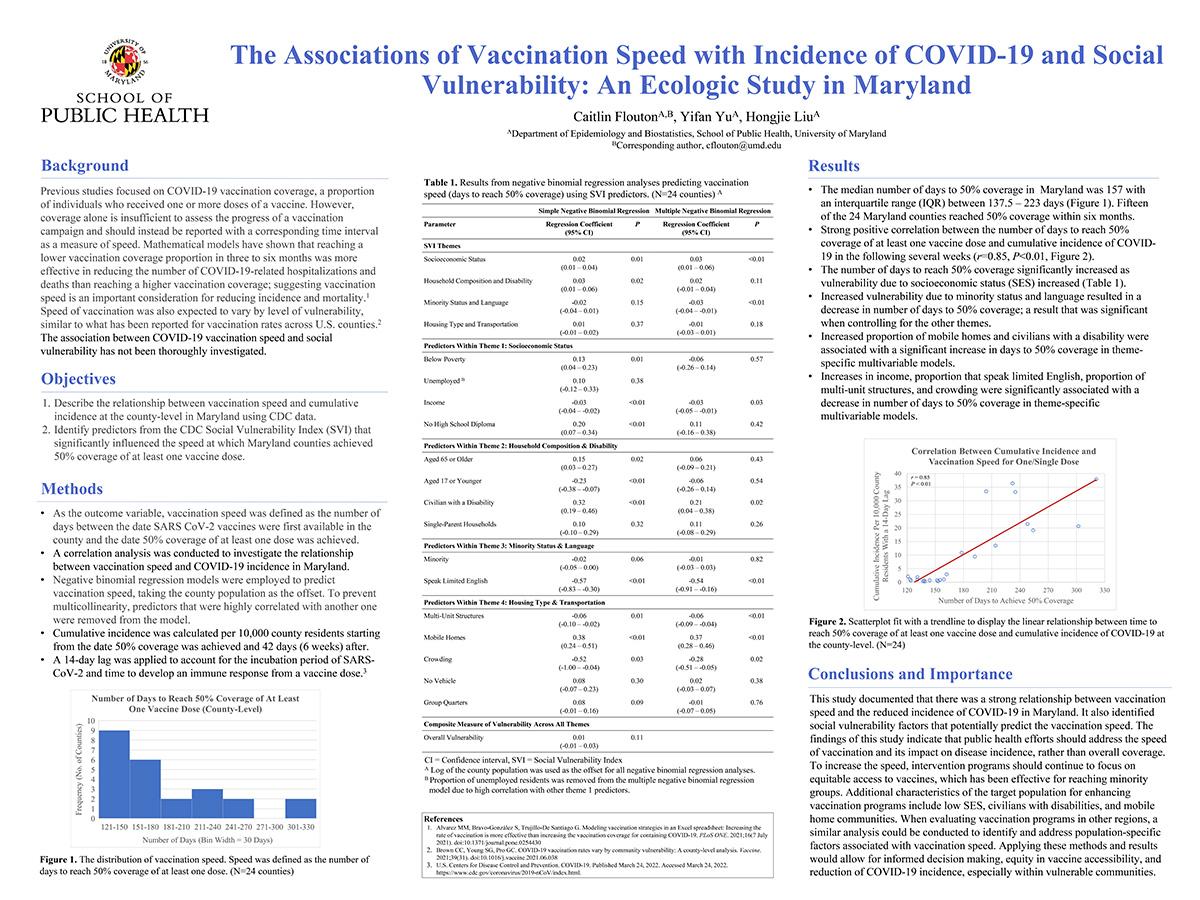
Poster #11
Title: The Associations of Vaccination Speed with Incidence of COVID-19 and Social Vulnerability: An Ecologic Study in Maryland
Presenting Author: Caitlin Flouton (doctoral student - Department of Epidemiology and Biostatistics, UMD School of Public Health)
Authors: Yifan Yu, Department of Epidemiology and Biostatistics, Doctoral Student; Hongjie Liu, Department of Epidemiology and Biostatistics, Faculty
Faculty Mentors: Hongjie Liu, PhD
Primary Category: COVID-19
Secondary Category: Healthy Equity, Racism and Social Injustice, Population Health, Immigration and Health
Background: Previous research investigated COVID-19 vaccination coverage, a proportion of individuals who received one or more doses of a vaccine. However, a more informative estimate of vaccination progress would include coverage with a corresponding time interval as a measure of speed.
Goals: The goal of this project was to describe the importance of vaccination speed and use regression models to identify county-level characteristics that influenced the speed at which Maryland counties achieved 50% coverage of least one COVID-19 vaccine dose.
Objectives: 1) Describe the relationship between vaccination speed and cumulative incidence at the county-level in Maryland using CDC data; and 2) Identify predictors from the CDC Social Vulnerability Index (SVI) that significantly influenced vaccination speed in Maryland.
Approach/Methods: This ecologic study included a correlation analysis to describe the relationship between vaccination speed and COVID-19 incidence in Maryland counties, and five multiple negative binomial regression models offset by county population to identify SVI predictors that significantly influence vaccination speed. As the outcome variable, vaccination speed was defined as the number of days between the date SARS CoV-2 vaccines were first available in the county and the date 50% coverage of at least one dose was achieved.
Results: Fifteen of the 24 Maryland counties reached 50% coverage within six months. The median number of days for the state was 157 with an interquartile range between 137.5 and 223 days. There was a strong positive correlation between the number of days to reach 50% coverage and cumulative incidence of COVID-19 in the following several weeks (r=0.85, P<0.01). Significant SVI predictors of vaccination speed included income, proportion of mobile homes, civilians with disabilities, speak limited English, multi-unit structures, and crowded households. The socioeconomic status and minority status SVI themes also significantly influenced vaccination speed.
Importance to public health: These findings indicate that public health efforts should address the speed of vaccination and its impact on disease incidence, rather than overall coverage. A similar analysis could be conducted to identify and address population-specific factors associated with vaccination speed in other regions to promote informed decision making, equity in vaccine accessibility, and reduction of COVID-19 incidence, especially within vulnerable communities.
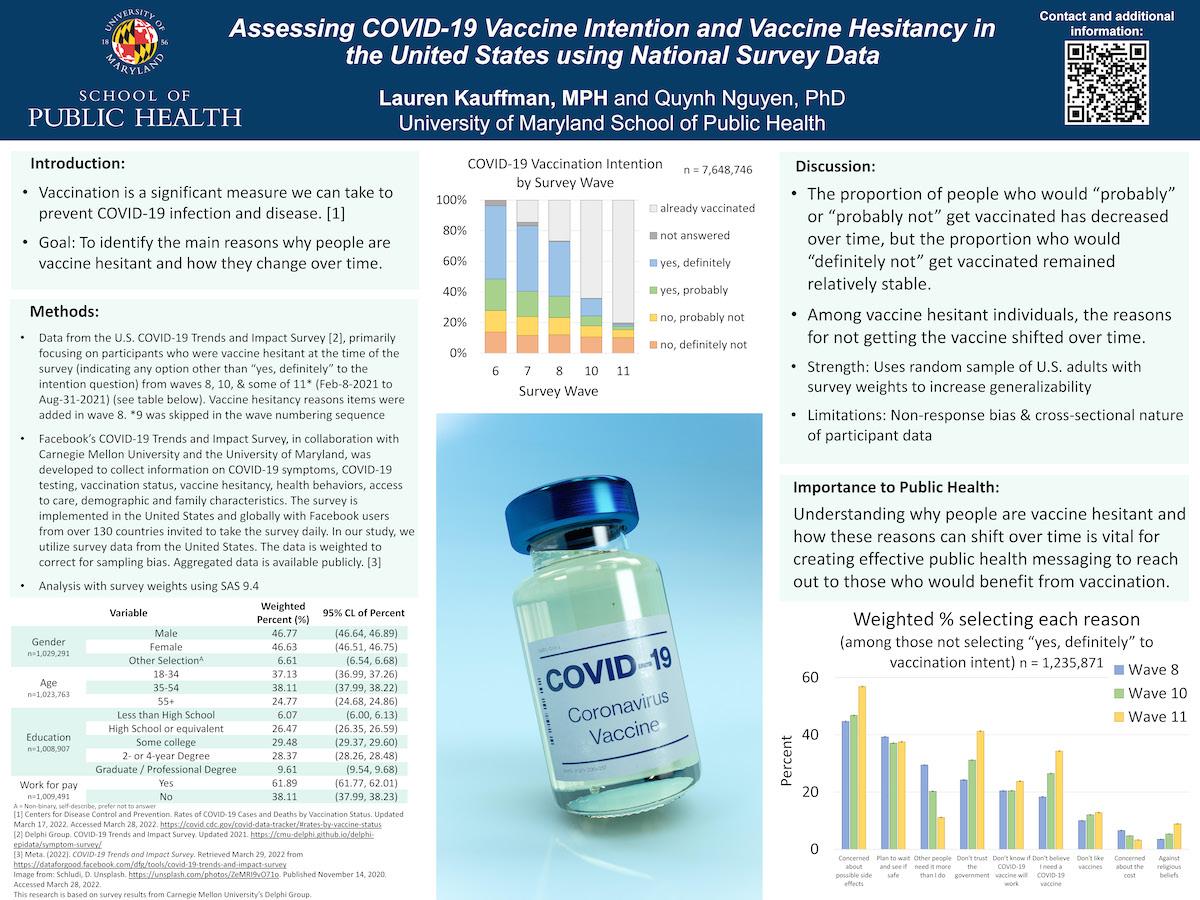
Poster # 13
Title: Assessing COVID-19 Vaccine Intention and Vaccine Hesitancy in the United States using National Survey Data
Presenting Author: Lauren Kauffman (doctoral student - Department of Epidemiology and Biostatistics, UMD School of Public Health)
Author: Quynh Nguyen, Faculty, UMD School of Public Health, Department of Epidemiology and Biostatistics
Faculty Mentors: Quynh Nguyen, PhD
Primary Category: COVID-19
Secondary Category: Data Analytics, Surveillance, Community Needs Assessment, Pedagogy
Background: Vaccination is a significant measure we can take to prevent COVID-19 infection and disease. However, a portion of the United States population experiences vaccine hesitancy, and these individuals have not gotten vaccinated despite their eligibility and the potential benefits.
Goals: The goal of this project is to identify the main reasons why people are vaccine hesitant and how those reasons change over time.
Objectives: The objective is to estimate and analyze 1) intention to get vaccinated on a scale from "yes, definitely" to "no, definitely not", 2) reasons for not "definitely" getting vaccinated, and 3) the ways in which the prevalence of those reasons change from one survey wave to the next. A secondary goal is to consider reasons for vaccine hesitancy as a function of intention.
Approach/Methods: Weighted frequencies were calculated and models were run with SAS 9.4.
Results: The proportion of people who would “probably” or “probably not” get vaccinated has decreased over time, but the proportion who would “definitely not” get vaccinated remained relatively stable. Among vaccine hesitant individuals, the reasons for not getting the vaccine shifted in prevalence over time.
Importance to public health: Understanding why people are vaccine hesitant and how these reasons can shift over time is vital for creating effective public health messaging to reach out to those who would benefit from vaccination.
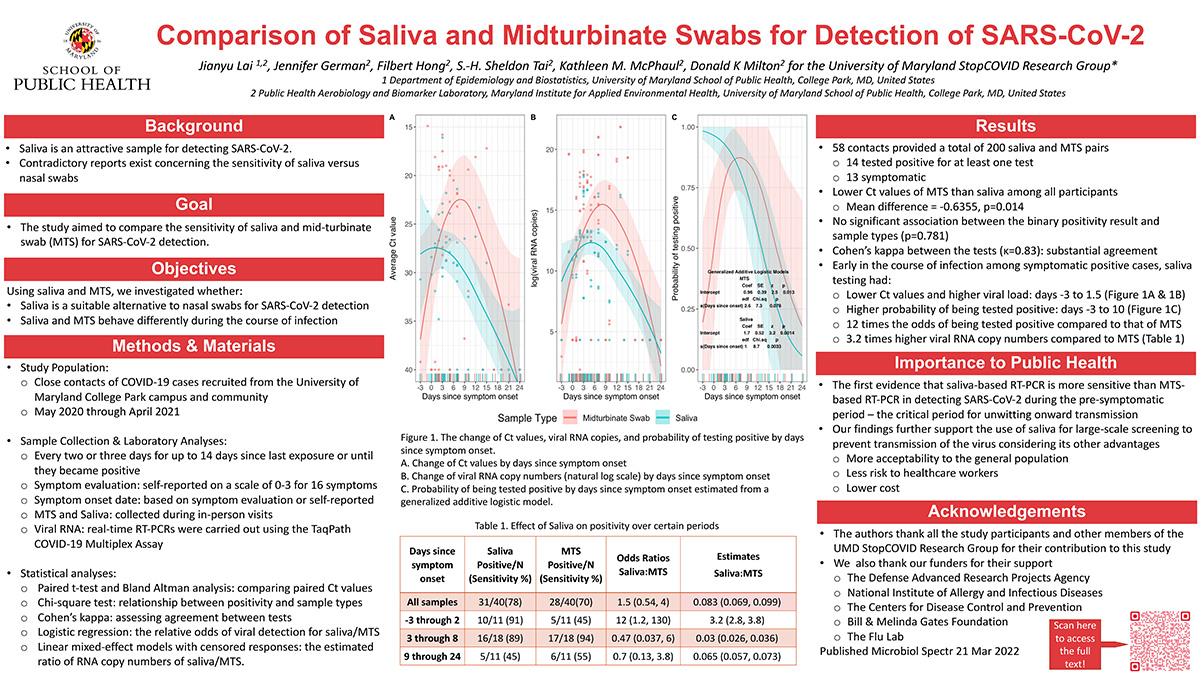
Poster # 14
Title: Comparison of Saliva and Midturbinate Swabs for Detection of SARS-CoV-2
Presenting Author: Jianyu Lai (doctoral student - Department of Epidemiology and Biostatistics, UMD School of Public Health)
Authors: Jennifer German,; Filbert Hong, ; S.-H. Sheldon Tai; Kathleen M. McPhaul, Donald K Milton, all in Maryland Institute for Applied Environmental Health, School of Public Health, University of Maryland, College Park
Faculty Mentors: Dr. Donald Milton
Primary Category: COVID-19
Secondary Category: Innovative Solutions to Public Health Challenges
Background: Saliva is an attractive sample for detecting SARS-CoV-2. However, contradictory reports exist concerning the sensitivity of saliva versus nasal swabs.
Goals: The study aimed to compare the sensitivity of saliva and mid-turbinate swab (MTS) for SARS-CoV-2 detection.
Objectives: By comparing the sensitivity of saliva and MTS, we investigated: 1) whether
saliva is a suitable alternative to nasal swabs for SARS-CoV-2 detection; and 2) whether the two types of samples perform differently during the course of infection.
Approach/Methods: From May 2020 to April 2021, we followed close contacts of COVID-19 cases for up to 14 days from their last exposure and collected self-reported symptoms, MTS, and saliva every two or three days. Samples were analyzed using real-time reverse transcription polymerase chain reaction (RT-PCR). Ct values from saliva and MTS were compared using paired t-test and Bland-Altman analysis, along with coefficient of determination and Pearson correlation coefficient. Chi-square test and Cohen’s Kappa were used to demonstrate the degree of agreement between the two sample types. Generalized additive logistic model was used to estimate the probability of being tested positive. Logistic regression and linear mixed-effect models with censored responses were used to estimate the relative odds of viral detection and the ratio of RNA copies of saliva to MTS.
Results: 58 contacts provided 200 saliva-MTS pairs; 14 contacts (13 with symptoms) had one or more positive samples. Saliva and MTS had similar rates of viral detection (p=0.78) and substantial agreement (κ=0.83). However, sensitivity varied significantly with time since symptom onset. Early on (days -3 to 2), saliva had 12 times (95%CI: 1.2, 130) greater likelihood of viral detection and 3.2 times (95% CI: 2.8, 3.8) higher RNA copy numbers compared to MTS. After day 2 post symptom onset, there was a non-significant trend toward greater sensitivity using MTS.
Importance to public health: This study presents the first evidence that saliva-based RT-PCR is more sensitive than MTS-based RT-PCR in detecting SARS-CoV-2 during the pre-symptomatic period – the critical period for unwitting onward transmission. Considering other advantages of saliva samples, our findings further support the use of saliva to identify pre-symptomatic infection and prevent transmission of the virus.
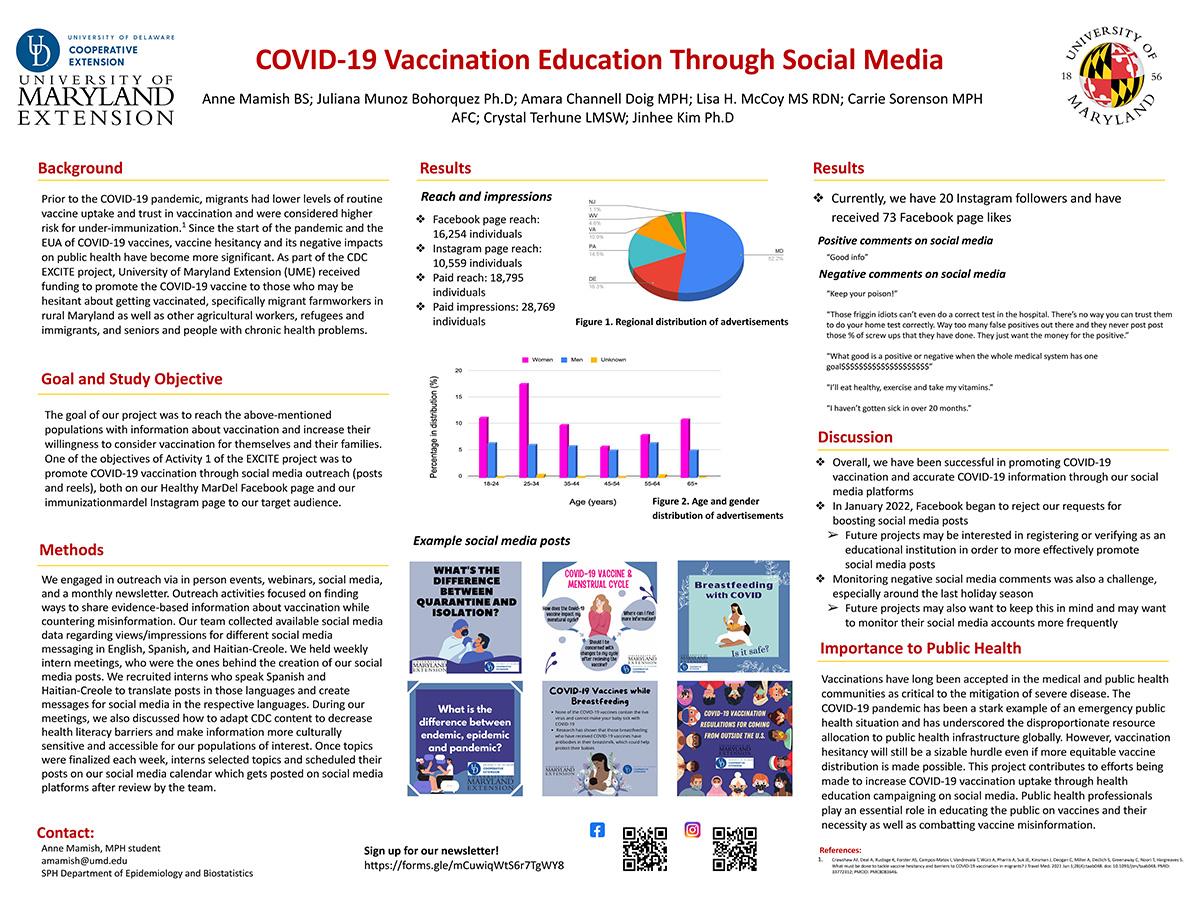
Poster # 15
Title: COVID-19 Vaccination Education Through Social Media
Presenting Author: Anne Mamish (master’s student - Department of Epidemiology and Biostatistics, UMD School of Public Health)
Authors: Juliana Munoz Bohorquez; UMD; student; Amara Channell Doig; UMD; student; Lisa H. McCoy; UME; Extension educator; Carrie Sorenson; UME; Extension educator; Crystal Terhune; UME; Extension educator; Jinhee Kim; UMD/UME; faculty
Faculty Mentors: Dr. Jinhee Kim
Primary Category: COVID-19
Secondary Category: Health Literacy, Health Communication, Health Education
Background: Migrants have been considered at higher risk for under-immunization given lower levels of routine vaccine uptake and trust in vaccination even prior to the COVID-19 pandemic. The EXCITE team received funding to improve vaccination coverage and to strengthen immunization education in our chosen population of migrant farmworkers in rural Maryland as well as other agricultural workers, refugees and immigrants, and seniors and people with chronic health problems.
Goals: The goal of our project was to reach the above-mentioned populations with information about vaccination and increase their willingness to consider vaccination for themselves and their families.
Objectives: One of the objectives of Activity 1 of the EXCITE project was to promote COVID-19 vaccination through social media outreach, both on Facebook and Instagram, to our target audience.
Approach/Methods: We held weekly intern meetings, including bilingual students who were proficient in Spanish and Haitian-Creole, who were the ones behind the creation of our social media posts. Interns created new posts or translated posts and created messages for social media in the respective languages directed towards our target demographic. During our meetings, we also discussed how to adapt CDC content to decrease health literacy barriers and make information more culturally sensitive and accessible for our populations of interest. Once topics were finalized each week, interns selected topics and scheduled their posts on our social media calendar which gets posted on social media platforms after review by the team.
Results: We have amassed a Facebook page reach of 16,251 individuals and an Instagram page reach of 10,559 individuals both through paid advertisements and organic social media growth. Paid reach and paid impressions through our boosted social media posts was 18,795 individuals and 28,769 individuals, respectively. Currently, we have 20 Instagram followers and have received 73 Facebook page likes.
Importance to public health: Public health professionals play an essential role in educating the public on vaccines and their necessity as well as combatting vaccine misinformation. This project contributes to efforts being made to increase COVID-19 vaccination uptake through health education campaigning on social media.
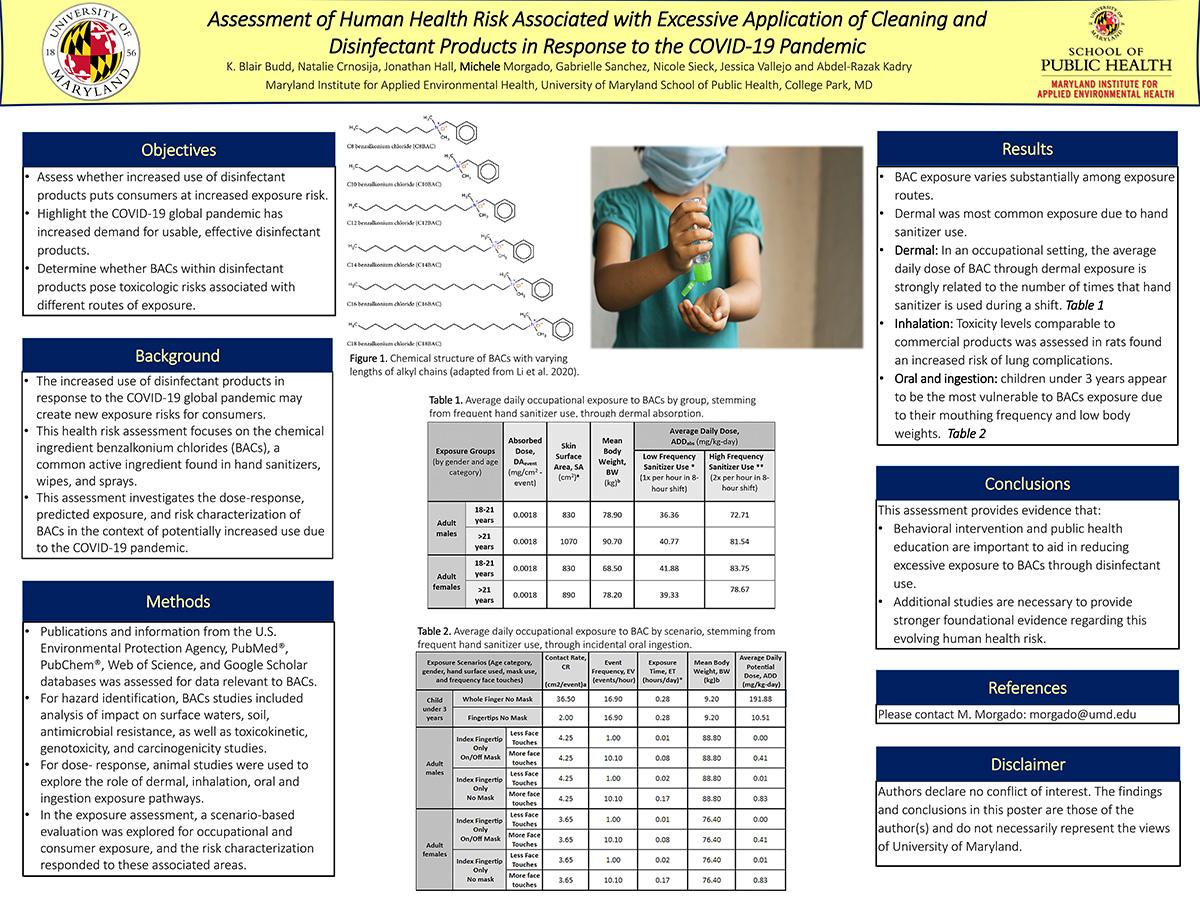
Poster # 16
Title: Assessment of Human Health Risk Associated with Excessive Application of Cleaning and Disinfectant Products in Response to the COVID 19 Pandemic
Presenting Author: Michelle Morgado (doctoral student- Maryland Institute for Applied Environmental Health, UMD School of Public Health)
Authors: K. Blair Budd; Maryland Institute for Applied Environmental Health UMD-SPH; student; Natalie Crnosija; Maryland Institute for Applied Environmental Health UMD-SPH; student; Nicole Sieck; Maryland Institute for Applied Environmental Health UMD-SPH; student; Jessica Vallejo; Maryland Institute for Applied Environmental Health UMD-SPH; student; Jonathan Hall; Maryland Institute for Applied Environmental Health UMD-SPH; student; Gabrielle Sanchez; Maryland Institute for Applied Environmental Health UMD-SPH; student
Faculty Mentors:Abdel Kadry, PhD
Primary Category: COVID-19
Secondary Category: Environmental Health, Occupational Health, Environmental Justice and Climate Change
Background: The increased use of disinfectant products in response to the COVID-19 global pandemic may create new exposure risks for consumers. Chemicals found in products like hand sanitizer, wipes, and sprays may pose a significant risk to human health through acute and long-term exposures, especially with increased product overuse and misuse. Evidence points to the occupational setting and behavior as the most common modes of exposure.
Goals: This human health risk assessment focuses on the chemical ingredient benzalkonium chlorides (BACs), the most common sub-class of quaternary ammonium compounds (QACs) found as an active ingredient in hand sanitizers, wipes, and sprays.
Objectives: This assessment investigates BACs’ dose-response, predicted exposure and risk characterization in the context of potentially increased use due to the COVID-19 pandemic.
Approach/Methods: To collect data relevant to BACs, we searched for the most recent publications and information from the U.S. Environmental Protection Agency, PubMed®, PubChem®, Web of Science, and Google Scholar databases. We manually reviewed reference lists of pertinent articles on this topic to find relevant research citations and hazard information made available by federally regulated information systems. The analysis was broken down into EPA’s four human health risk assessment steps (2017). In each step, relevant data was extracted and synthesized.
Results: BAC exposure varies substantially among exposure routes, such as dermal, inhalation, oral/ingestion, with dermal exposure being the most common due to the increased use of hand sanitizers. Studies found potential health risks due to the use of these popular products included allergic skin dermatitis, skin wounds, and blistering. Inhalation exposure was also found to be of concern due to increased use of spray disinfectants and has been associated with increased risk of lung complications, such as chronic obstructive pulmonary disease and lung fibrosis. Oral and ingestion exposure is another area of concern due to hand-to-mouth contact, especially among children under 3-yrs of age who may not effectively use protective barriers.
Importance to public health: Behavioral intervention and public health education are important to aid in reducing excessive exposure to BACs. Teaching essential workers and consumers about the importance of handwashing with soap and water and risks associated with hand sanitizer overuse can help in reducing exposure.
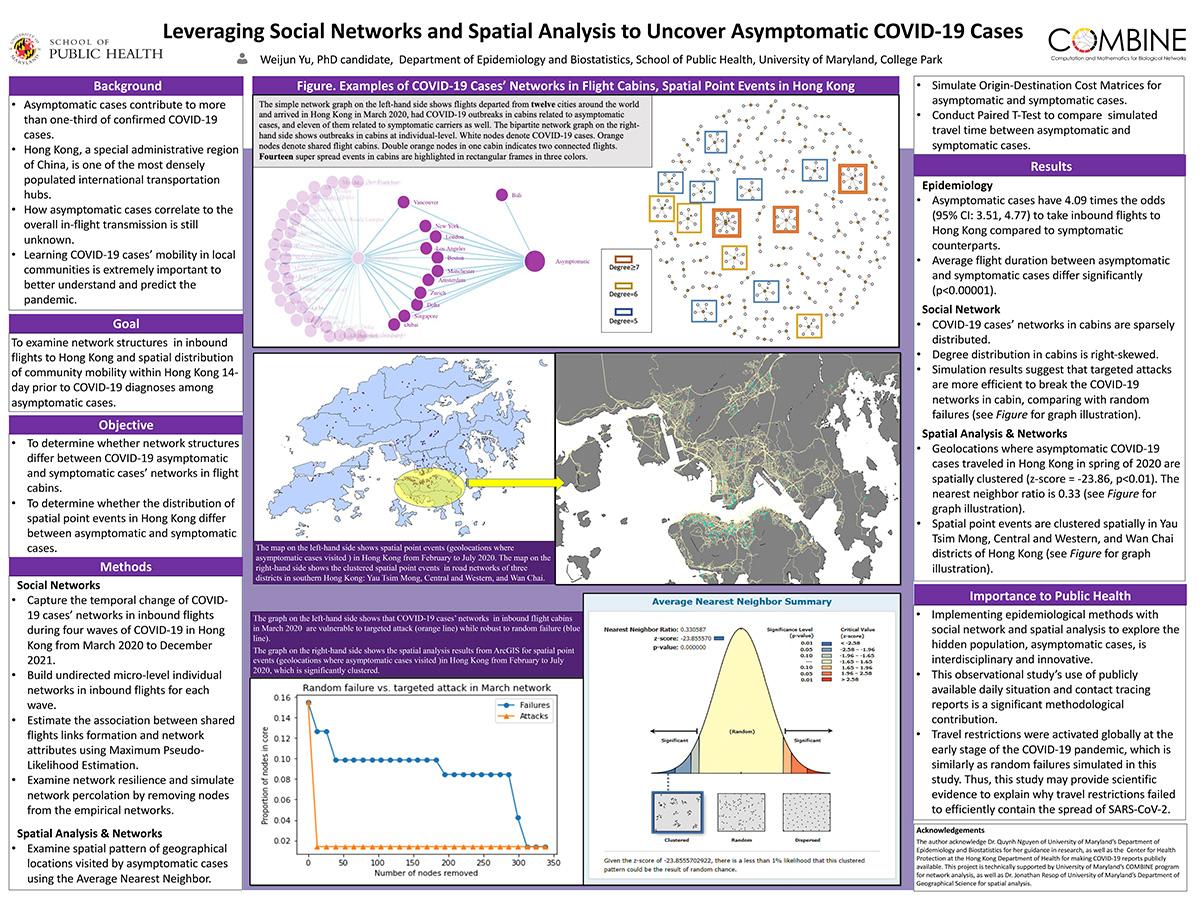
Poster # 17
Title: Leveraging Social Networks and Spatial Analysis to Uncover Asymptomatic COVID-19 Cases
Presenting Author: Weijun Yu (doctoral student - Department of Epidemiology and Biostatistics, UMD School of Public Health)
Faculty Mentors: Quynh Nguyen, PhD
Primary Category: COVID-19
Secondary Category: Innovative Solutions to Public Health Challenges
Background: How asymptomatic cases correlate to the overall in-flight transmission is still unknown.
Learning COVID-19 cases’ mobility in local communities is extremely important to better understand and predict the pandemic.
Goals: To examine network structures in inbound flights to Hong Kong and spatial distribution of community mobility within Hong Kong 14- day prior to COVID-19 diagnoses among asymptomatic cases.
Objectives:
- To determine whether network structures differ between COVID-19 asymptomatic and symptomatic cases’ networks in flight cabins.
- To determine whether the distribution of spatial point events in Hong Kong differ between asymptomatic and symptomatic cases.
Approach/Methods: Examine network resilience and simulate network percolation by removing nodes from the empirical networks. Examine spatial pattern of geographical locations visited by asymptomatic cases using the Average Nearest Neighbor.
Results: Asymptomatic cases have 4.09 times the odds (95% CI: 3.51, 4.77) to take inbound flights to
Hong Kong compared to symptomatic counterparts.
COVID-19 cases’ networks in cabins are sparsely distributed. Simulation results suggest that targeted attacks are more efficient to break the COVID-19 networks in cabin, comparing with random failures.
Geolocations where asymptomatic COVID-19 cases traveled in Hong Kong in spring of 2020 are spatially clustered (z-score = -23.86, p<0.01). The nearest neighbor ratio is 0.33 (see Figure for graph illustration).
Importance to public health: Implementing epidemiological methods with social network and spatial analysis to explore the hidden population, asymptomatic cases, is interdisciplinary and innovative. Travel restrictions were activated globally at the early stage of the COVID-19 pandemic, which is similarly as random failures simulated in this study. Thus, this study may provide scientific evidence to explain why travel restrictions failed to efficiently contain the spread of SARS-CoV-2.
